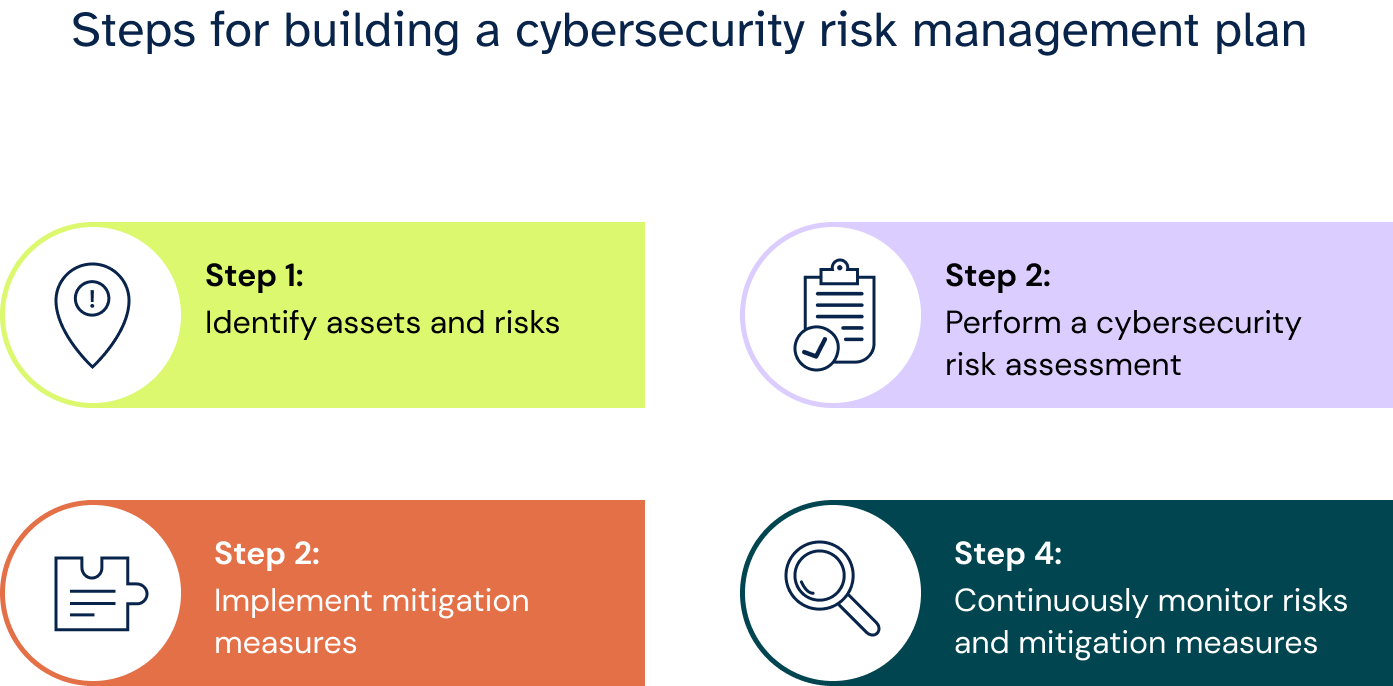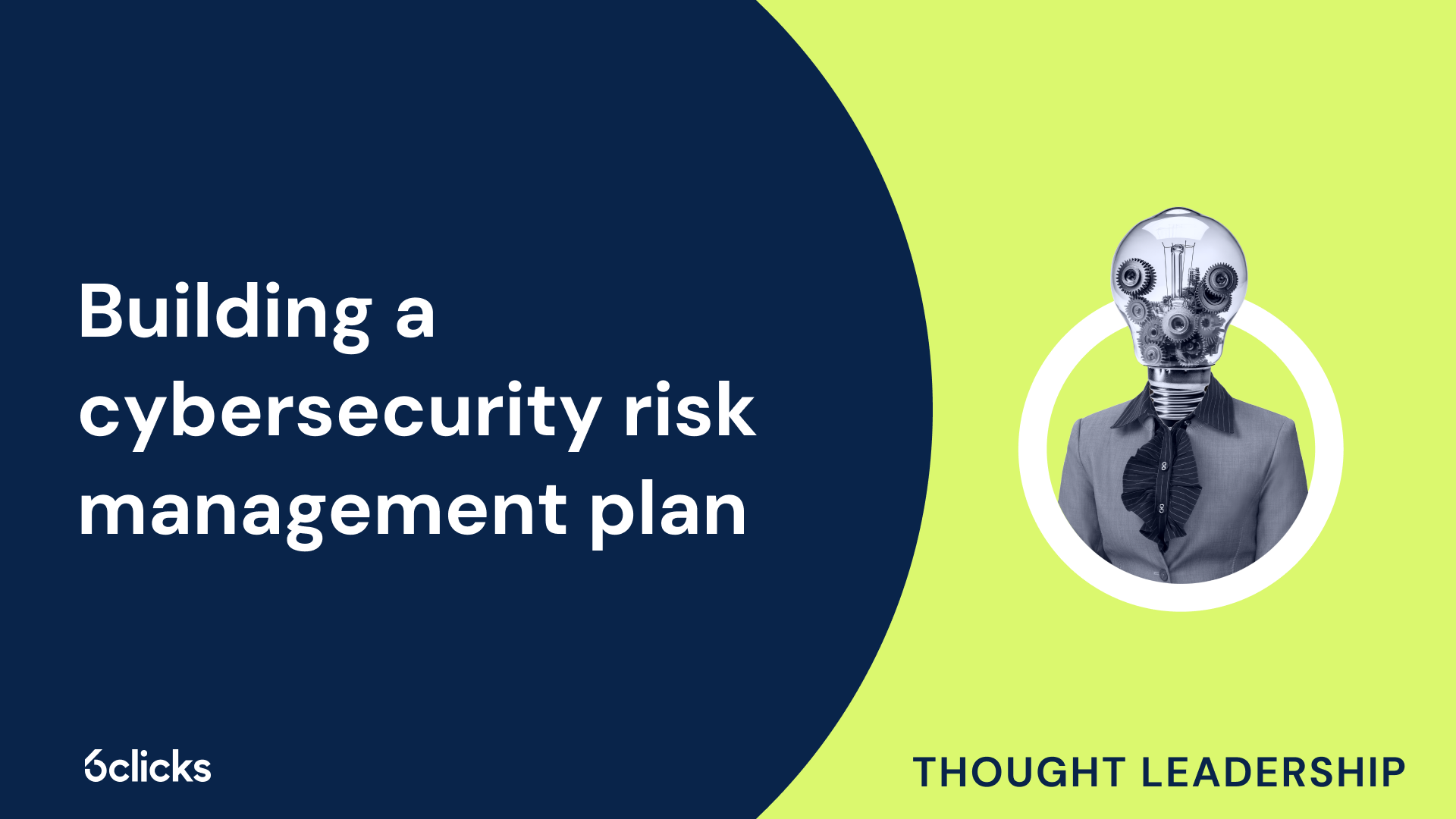With today’s organizations navigating complex technology infrastructures, a vast network of third parties, and increasingly stringent laws and regulations, the need to manage cybersecurity risks is more important than ever. Cybersecurity risk management enables organizations to eliminate or mitigate potential threats to their systems and operations and effectively safeguard valuable data and assets.
In this article, we will discuss the significance of cybersecurity risk management, what the process entails, relevant frameworks, and how your organization can build a cybersecurity risk management plan and leverage the 6clicks platform to achieve cyber resilience.
What is cybersecurity risk management?
Cybersecurity risk management refers to the process of identifying, evaluating, and addressing your organization’s cyber threats and continuously improving risk management measures. It allows for the effective prioritization of risks based on the level of impact they pose to the organization. Implementing cybersecurity risk management empowers organizations to ensure that they have the necessary systems, processes, and controls in place to respond to threats in a timely manner. This approach also helps organizations:
- Combat a wide range of threats: From cyber threats such as malware and phishing, to natural disasters, system failures, and human error, a cybersecurity risk management plan can protect your organization from diverse types of threats
- Uphold data privacy and security: By proactively addressing risks, organizations can demonstrate their capability to prioritize the accessibility, confidentiality, and integrity of data and bolster customer and stakeholder trust
- Facilitate regulatory compliance: With a cybersecurity risk management plan, organizations can achieve compliance with various laws and regulations that mandate requirements for managing cyber and information security risks
- Maintain business continuity: An effective cybersecurity risk management strategy enables organizations to reduce downtime and maintain critical functions in the event of a disruption, promoting operational resilience
- Avoid damages and additional costs: Establishing a cybersecurity risk management plan allows organizations to prevent reputational, operational, and legal damages and their associated costs
The cybersecurity risk management process
From security teams handling the implementation and maintenance of controls and technologies, to risk and compliance teams identifying risks and assessing the effectiveness of security measures, the process of cybersecurity risk management involves the collaboration of the entire organization. It consists of four steps based on the organization’s risk profile, risk prioritization, risk tolerance, and regulatory and security requirements.
- Identifying risks – The first step of the cybersecurity risk management process encompasses a thorough examination of the organization’s environment to identify all current and potential risks to its assets, systems, operations, and stakeholders
- Assessing risks – Next, identified risks are assessed based on their likelihood and impact to determine the priority level for each risk
- Mitigating risks – High-priority risks are then remediated first through a set of actions and security measures that must align with internal security requirements and external compliance obligations
- Monitoring risks – Lastly, the effectiveness of mitigation measures must be evaluated on an ongoing basis and improved as necessary
Cybersecurity risk management frameworks
There are several compliance standards and frameworks that organizations can use to guide their cybersecurity risk management. Here are some of them:

- ISO 27001 – A standard developed by the International Organization for Standardization that outlines requirements and controls for building an Information Security Management System (ISMS) with a primary focus on risk management
- NIST CSF – The National Institute of Standards and Technology’s Cybersecurity Framework provides organizations with guidelines for managing cybersecurity risks using six core functions: Govern, Identify, Protect, Detect, Respond, and Recover
- SOC 2 – A cybersecurity compliance framework, the System and Organization Controls Type 2 provides five Trust Service criteria for managing risks to customer data: Security, Availability, Confidentiality, Privacy, and Processing Integrity
- NIST RMF – The NIST Risk Management Framework specifies a 7-step process: Prepare, Categorize, Select, Implement, Assess, Authorize, and Monitor for U.S. government agencies to manage cyber risks and ensure information security and privacy. It also includes the Security and Privacy Controls for Federal Information Systems and Organizations (SP 800-53), which are a set of security controls that entities handling federal data must implement in compliance with the requirements of the Federal Information Security Management Act (FISMA).
- CMMC – A Cybersecurity Maturity Model Certification is mandatory for organizations working with the U.S. Department of Defense. The CMMC program provides information security requirements and a framework for control implementation based on three maturity levels to safeguard sensitive information from various cyber threats.
Steps for building a cybersecurity risk management plan
Incorporating the process outlined above, you can create a cybersecurity risk management plan through the following steps:

Step 1: Identify assets and risks
Start by identifying and classifying your organization’s assets and data to determine their equivalent risks. This involves defining the vulnerabilities or weaknesses in your systems and processes as well as the threats or potential dangers that your organization faces in relation to these vulnerabilities.
Step 2: Perform a cybersecurity risk assessment
Once you have identified your assets and risks, you can then perform a risk assessment to measure the likelihood and impact of risks and assign a priority level to each risk. During the risk assessment is also when you must decide whether to prevent, accept, transfer, resolve, or mitigate a risk and define the action steps your organization will take to correct or reduce its impact in the form of a risk treatment plan.
Step 3: Implement mitigation measures
Creating a risk treatment plan involves delineating specific actions and security measures to mitigate or remediate risks. These can include adopting cybersecurity technologies such as firewalls and multi-factor authentication tools, enforcing controls like data encryption and access management, establishing processes such as vendor risk assessments and incident response, and conducting security training for all employees to foster risk awareness and preparedness across the entire organization. Mitigation measures can also come in the form of process improvements, which can include adjusting policies and updating existing controls and procedures to address non-conformities and eliminate inefficiencies.
Step 4: Continuously monitor risks and mitigation measures
To bring the process full circle, risks and mitigation measures must be continually reviewed and evaluated to identify and assess new threats and improve security measures and procedures. Aside from putting monitoring systems in place, conducting regular security assessments and internal audits allows your organization to verify the effectiveness of controls and processes and implement corrective actions as needed.
Streamline cybersecurity risk management with 6clicks
Harness the robust capabilities of the 6clicks platform to integrate the cybersecurity risk management process into your organization and achieve comprehensive protection against diverse threats.
Access risk management frameworks such as the ISO 27001, NIST CSF, and CMMC from the 6clicks Content Library and utilize turnkey control sets, risk libraries, and assessment templates to expedite your compliance process.
Using 6clicks’ Asset Management feature, create custom registers to store and categorize your assets. Then, with 6clicks’ IT Risk Management solution, you can take advantage of built-in risk libraries, organize and assess your risks in a structured risk register, and assign mitigation or remediation actions to team members.
Meanwhile, you can catalog and put in place your controls and procedures within the Controls module and validate their effectiveness by conducting audits and assessments, all in one platform. In addition, you can support risk mitigation measures with 6clicks’ Vendor Risk Management and Issue & Incident Management solutions.
Lastly, get an overview of the status of risks, track the progress of risk treatment plans, and check the performance of controls through 6clicks’ Reporting & Analytics capabilities.
Frequently asked questions
What are the benefits of cybersecurity risk management?
Cybersecurity risk management enables organizations to safeguard their data and assets against a variety of threats, uphold security, privacy, and regulatory compliance, achieve operational resilience, and avoid reputational damage.
What are the components of cybersecurity risk management?
A cybersecurity risk management plan consists of actions and security measures for resolving or reducing the impact of a risk. These can include implementing controls like data encryption and access management, establishing processes such as vendor risk assessments and incident response, and improving policies and procedures.
How do you build a cybersecurity risk management plan?
To build a cybersecurity risk management plan, you must first identify your assets and risks, prioritize risks based on their likelihood and impact, and enforce mitigation measures which are then continuously reviewed and improved.
Written by Heather Buker
Heather has been a technical SME in the cybersecurity field her entire career from developing cybersecurity software to consulting, service delivery, architecting, and product management across most industry verticals. An engineer by trade, Heather specializes in translating business needs and facilitating solutions to complex cyber and GRC use cases with technology. Heather has a Bachelors in Computer Engineering, Masters in Engineering Management, and a Doctorate in Information Technology with a specialization in information assurance and cybersecurity.












